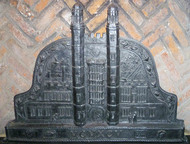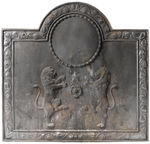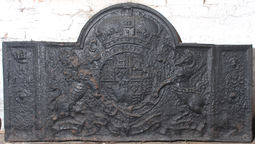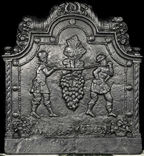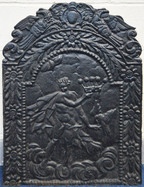-
1179
Description: Arched rectangular shape; astragal and fillet edging (top and sides); central shield with arms of Eton College, surmounted by a small tilting shield of the pre-1603 Royal arms of England (France modern quartering England) aslant beneath a crown; to each side a spray of lilies; below, a scroll bearing the motto - Esto Perpetua; bottom left the date MCMXCII; bottom right, a panel bearing the phrase C of A and [?].
Notes: The motto Esto Perpetua means Let it be perpetual. Fireback designed by and made for Martin, Lord Charteris of Armisfield, who was Provost of Eton College 1978-91. One of a set of two cast for the college.
Copies of this fireback are known.
Inscription: ESTO PERPETUA / MCMXCII C of A [Charteris of Armisfield]
Arms: Eton College
- Decoration tags:
- rectangular with round arch (shape)
- astragal & fillet (edging)
- whole carved pattern
- heraldic
- armorial
- text
- plants
Manufactured: in 1992 in England.
Current location: Eton College, Eton, Berkshire, England.
Museum number: FDA-A.238:2-2013 (part of the Eton College museum group)
- Attached to series:
- Martin Charteris firebacks
- Corporate firebacks
-
1180
Description: Quasi-arched rectangular shape; parallel simulated twisted rope edging enclosing a border of lilies; pictorial representation of the facade and gatehouse towers of Eton College, between which is a clockface below crenellation; above left, two house martins flying; at ground level, ?four people (one of which is said to be Nigel Jaques, one of the masters) all standing on a plinth bearing, in the centre, the date MCMXCV between four small cartouches, of which to the left and nearest the date is a pack of playing cards; others bear the inscriptions, MCM and CofA (Charteris of Armisfield).
Notes: Designed by and made for Martin, Lord Charteris of Armisfield, Provost of Eton (1978-91).
Inscription: MCMXCV
- Decoration tags:
- rectangular with round arch (shape)
- rope (edging)
- whole carved pattern
- pictorial
- architectural
- monogram
- text
- animals
- humans
Manufactured: in 1995 in England.
Current location: Eton College, Eton, Berkshire, England.
Museum number: FDA-A.298-2013 (part of the Eton College museum group)
- Attached to series:
- Martin Charteris firebacks
-
365
Description: Arched rectangular shape; astragal edging with parallel astragal enclosing a border of undulating convolvulus vine, leaves and flowers; bead and disc circle in arch, above a pair of lions rampant facing each other, between which are a five-pointed star above a rose.
Notes: A fireback in a retro-Regency style. Sotheby's auction, 27 Oct 2010, lot 209 (£2,500)
Copies of this fireback are known.
- Decoration tags:
- rectangular with round arch (shape)
- astragal (edging)
- whole carved pattern
- heraldic
- animals
Manufactured: in the late-19th to early-20th century in England.
Current location: in private hands, Lambourn, Berkshire, England.
- Attached to series:
- Miscellaneous pattern firebacks
-
449
Description: Arched rectangular shape; cavetto edging; armorial; Stuart English royal arms within a circular garter; crown, motto and supporters (crowned lion and unicorn); initials separated by crown; left rectangular extension panel with double ovolo-moulded edging; top, putto face above initials in triad, with floral patera below; right rectangular extension panel with double ovolo-moulded edging; top, putto face above date, with floral patera below.
Notes: A widely copied armorial fireback with extension panels of a style associated with other date and initial firebacks; the central fireback measures 1080 x 860mm.
Inscription: [central fireback] C [R missing] / ..I SOI T.QVI.MAL.Y. ...SE; [left panel] IRM [triad]; [right panel] 1686
Arms: English Stuart royal
- Decoration tags:
- rectangular with round arch (shape)
- complex individual (edging)
- carved stamps
- whole carved pattern
- individual letters
- individual numbers
- extension panels
- armorial
- royal
- text
Manufactured: in 1686 in the Weald area of England.
Current location: Anne of Cleves House, Southover High Street, Lewes, East Sussex, England.
Museum number: LH000.951 (part of the Sussex Archaeological Society museum group)
- Attached to series:
- Carolean royal armorial firebacks
- Stuart royal armorial firebacks
-
584
Description: Of unique design; quasi-arched rectangular shape; ribbon border, curled on each side of the neck. Symmetrical arrangement of plant tendrils with acorns, oak leaves, pomegranates and other leaves across the rectangular base; above and centrally placed are the date, over which are the initials either side of a crescent moon, surmounted by an earl’s coronet.
Notes: The initials, H N, are thought to refer to Henry, 9th Earl of Northumberland, and the date to his release from the Tower of London following his 17 years’ imprisonment for alleged involvement in the Gunpowder Plot.
Copies of this fireback are known.
Inscription: H N / 1622
- Decoration tags:
- rectangular with round arch (shape)
- complex individual (edging)
- whole carved pattern
- heraldic
- text
- plants
Manufactured: in 1622 probably at Frith Furnace, Northchapel in the Weald area of England.
Current location: Petworth House, Petworth, West Sussex, England.
Museum number: 485698 (part of the National Trust museum group)
- Attached to series:
- Personal firebacks
- Petworth lettering series
-
944
Description: Cavetto-canted arched rectangular shape; double fillet edging on top, pilasters with diagonal striping at sides; double bead and pellet moulding parallel to, and inside fillet, enclosing pictorial representation of Joshua and Caleb carrying an outsize bunch of grapes; below them, at each side, a basket of flowers and fruit, and between them a cartouche with a date; on top, two symmetrical cornucopiae spilling their contents down the canted shoulders of the plate; at bottom, a plain extension panel.
Notes: The image is derived from a fireback of c.1700, in the series identified by the letters GK, as is the date cartouche. This is a contrived design using elements from another fireback.
Inscription: [indecipherable poss. 1700]
- Decoration tags:
- rectangular with canted top corners and round arch (shape)
- complex individual (edging)
- carved pattern panels
- extension panels
- pictorial
- biblical
- text
- humans
- plants
Manufactured: in the 19th century in France.
Current location: not known.
- Attached to series:
- Joshua and Caleb firebacks
- 'Dutch' GK series
-
1092
Description: Arched rectangular central panel with bead edging; caped naked male figure standing on clouds, head turned over his right shoulder and holding a coronet of five raised baubles aloft in his right hand, on his left hand a bird perched, its wings displayed; above left a cloud; arched rectangular fillet border containing symmetrical, regularly-spaced 'daisy' flowers and festoons of leaves descending there from; on top of the arch, a central cartouche with a mirrored eagle and scrolls on each side.
Notes: The bottom panel of the border is missing, perhaps through breakage, the bottom flower on each side being incomplete and the fillet edging discontinued. The figure, which has yet to be identified, is probably iconic or mythological. The form of the arch suggests an English origin.
- Decoration tags:
- 'Dutch' (shape)
- fillet (edging)
- whole carved pattern
- allegorical
Manufactured: in the late-17th to early-18th century in England.
Current location: not known.
- Attached to series:
- British 'Dutch' style firebacks

